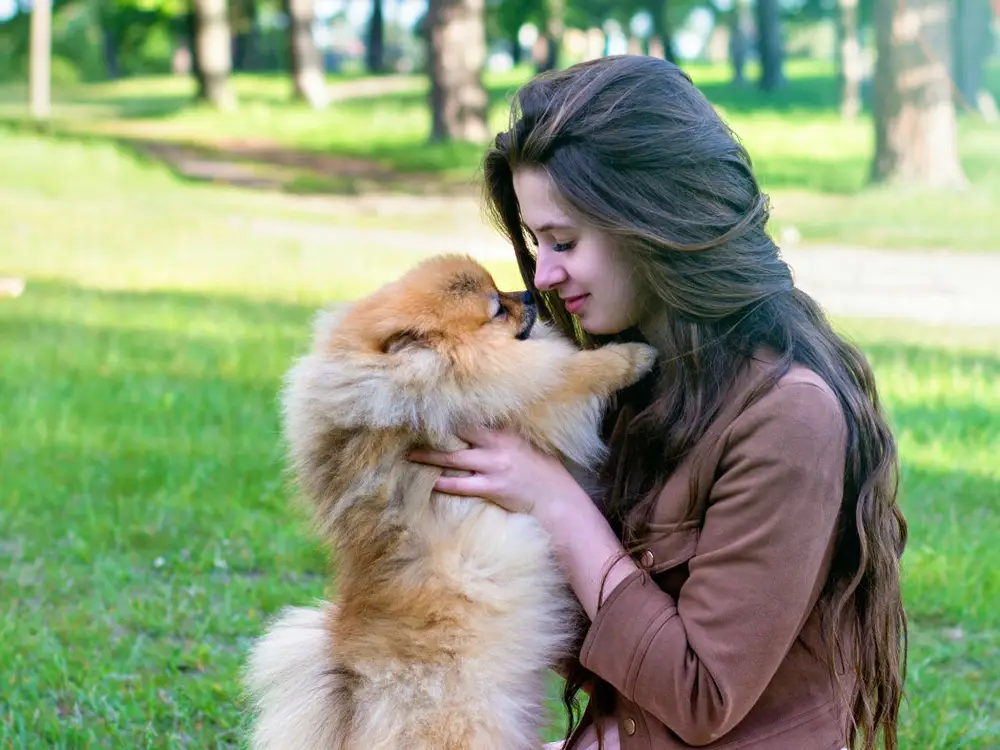Why Do Dogs Stand on You?
Have you ever experienced the delightful yet perplexing behavior of your furry companion standing on you? Whether it’s a small Chihuahua or a large Great Dane, dogs have a tendency to position themselves on top of their owners, often leaving us wondering why they engage in such behavior. While it may seem strange at first, there are several reasons why dogs exhibit this seemingly odd habit. In this article, we will explore the various factors that contribute to dogs standing on their owners and delve into the possible explanations behind this endearing yet puzzling behavior.
One possible reason for a dog’s inclination to stand on you is their desire for attention and affection. Dogs are known for their social nature and strong bond with their human companions. By physically placing themselves on top of you, they are seeking physical contact and closeness, as well as the reassurance of your presence. This behavior can be seen as an expression of their love and dependence on their owners.

Another factor that may contribute to dogs standing on you is their instinctual need for hierarchy and dominance. In the wild, dogs live in packs with a clear social structure, and each member has a designated rank. By positioning themselves on top of you, dogs may be asserting their dominance or attempting to establish their role within the household hierarchy. This behavior can be particularly noticeable in dogs with assertive or dominant personalities.
Furthermore, dogs may stand on you as a means of seeking comfort and security. Just like humans, dogs can experience anxiety or fear in certain situations. By standing on their owners, dogs find solace and feel protected. Your presence provides them with a sense of security, and physically being on top of you helps alleviate their anxiety and stress.
It is essential to note that the behavior of dogs standing on their owners can also be influenced by individual personalities, breed traits, and past experiences. Some dogs may have learned that standing on their owners leads to positive reinforcement, such as attention or treats, which further reinforces this behavior.
Understanding why dogs stand on you is crucial for developing a deeper bond with your furry friend. By recognizing their needs for attention, affection, hierarchy, and security, you can respond appropriately and provide them with the love and reassurance they seek. In the following sections, we will dive deeper into the main reasons behind this behavior and explore practical recommendations to address it effectively.
The Curious Behavior: Why Do Dogs Stand on You?
1. Seeking Attention and Affection
One of the primary reasons why dogs stand on their owners is their innate desire for attention and affection. Dogs are social creatures that thrive on human companionship and interaction. By positioning themselves on top of you, they are actively seeking physical contact and closeness. This behavior can be seen as their way of expressing love and dependence on their owners. It is their way of saying, “I want to be close to you, I want your attention, and I want your affection.”
2. Instinctual Need for Hierarchy and Dominance
Dogs are descendants of wolves, who live in packs with a clear social structure. Within these packs, each member has a designated rank or position. When a dog stands on you, it may be an instinctual behavior related to hierarchy and dominance. By physically placing themselves above you, they may be asserting their dominance or trying to establish their role within the household hierarchy. This behavior is more commonly observed in dogs with assertive or dominant personalities, but it can be seen in dogs of all breeds.
3. Seeking Comfort and Security
Another reason why dogs stand on their owners is their need for comfort and security. Dogs can experience anxiety or fear in certain situations, and standing on their owners provides them with a sense of safety and protection. Your presence acts as a calming influence, and physically being on top of you helps alleviate their anxiety and stress. It is their way of seeking reassurance and finding solace in your presence.
4. Individual Personalities, Breed Traits, and Past Experiences
It is important to understand that the behavior of dogs standing on their owners can also be influenced by individual personalities, breed traits, and past experiences. Some dogs may have learned that standing on their owners leads to positive reinforcement, such as attention or treats, which further reinforces this behavior. Additionally, certain breeds may have a natural inclination to be more physically affectionate or seek close contact with their owners.
Conclusions
In conclusion, understanding the quirky behaviors of our canine companions, such as why do dogs stand on you, can deepen the bond between pet and owner while ensuring the well-being of our furry friends. For more insights into dog behavior and how to foster a positive relationship with your pet, visiting Geepets.com can provide a wealth of information.
Additionally, for a broader perspective on canine behaviors and health, resources like the American Kennel Club offer extensive guidance and advice to help pet owners navigate the joys and challenges of dog ownership. Whether you’re curious about your dog’s sleeping habits, why they choose to stand on you, or other peculiar behaviors, these resources can offer valuable information and peace of mind.

Practical Recommendations for Dealing with Dogs Standing on You
1. Establish Boundaries and Reinforce Training
If your dog’s habit of standing on you becomes excessive or undesirable, it’s important to establish clear boundaries. Teach your dog basic obedience commands such as “sit” or “down” and reinforce these commands consistently. By providing them with alternative behaviors to engage in, you can redirect their attention and discourage them from standing on you.
2. Create a Comfortable Space for Your Dog
Dogs often seek physical contact as a way to find comfort and security. Provide your dog with a cozy and designated space of their own, such as a comfortable bed or a designated area in your home. Encourage them to use this space by offering treats, toys, or blankets. Having their own space can help reduce their need to stand on you for comfort.
3. Encourage Independent Play and Exercise
Engaging your dog in regular exercise and independent play can help channel their energy and reduce their need for constant physical contact, addressing the question of why do dogs stand on you. By providing them with stimulating toys, puzzle games, or interactive play sessions that allow them to entertain themselves, you tackle the underlying issue behind why do dogs stand on you.
This approach not only diverts their energy into more constructive activities but also directly addresses the curiosity surrounding why do dogs stand on you. It can significantly alleviate their desire to stand on you for attention or stimulation, offering a clear solution to the often-asked question, why do dogs stand on you. Incorporating these strategies effectively responds to the behavior by minimizing the reasons why do dogs stand on you, ensuring they have healthier outlets for their energy and curiosity.
4. Reinforce Positive Behavior with Rewards
When your dog chooses not to stand on you and instead engages in desirable behaviors, such as sitting or lying down, make sure to reward them with praise, treats, or affection. Understanding why do dogs stand on you is crucial in addressing this behavior. Positive reinforcement can be a powerful tool in shaping your dog’s behavior. By rewarding them for appropriate actions, you encourage them to continue displaying those behaviors instead of the issue at hand, which is why do dogs stand on you.

It’s essential to consider why do dogs stand on you in the first place, as it often stems from a desire for attention or as a way of showing dominance. By focusing on the question of why do dogs stand on you and redirecting their behavior positively, you significantly improve the chances of modifying this behavior. Every time your dog opts for a more acceptable behavior over standing on you, reinforcing that choice becomes a step towards understanding and addressing the underlying reasons behind why do dogs stand on you.
5. Seek Professional Guidance if Needed
If your dog’s behavior persists or becomes problematic, it may be beneficial to consult with a professional dog trainer or behaviorist, especially if you’re wondering, “Why do dogs stand on you?” They can assess the underlying reasons for your dog’s behavior, including exploring the question of “Why do dogs stand on you?” and provide tailored guidance and training techniques to address the issue effectively.
Our featured products:
Professional guidance can be especially helpful if your dog’s behavior, which might include wondering, “Why do dogs stand on you?” is rooted in anxiety, fear, or dominance-related issues. Understanding the motivations behind actions like “Why do dogs stand on you?” can offer insights into their behavior and how best to address it, ensuring a healthier relationship between you and your pet.
6. Ensure Regular Veterinary Check-ups
Sometimes, dogs may exhibit unusual behaviors due to underlying health issues or discomfort. Ensure that your dog receives regular veterinary check-ups to rule out any medical conditions that may contribute to their behavior. Your veterinarian can provide valuable insights and recommendations based on your dog’s specific health needs.
Remember, each dog is unique, and what works for one may not work for another. Patience, consistency, and understanding are key when addressing your dog’s behavior. By implementing these practical recommendations and providing a loving and secure environment, you can help your dog find alternative ways to seek attention and comfort while strengthening the bond between you and your furry companion.















